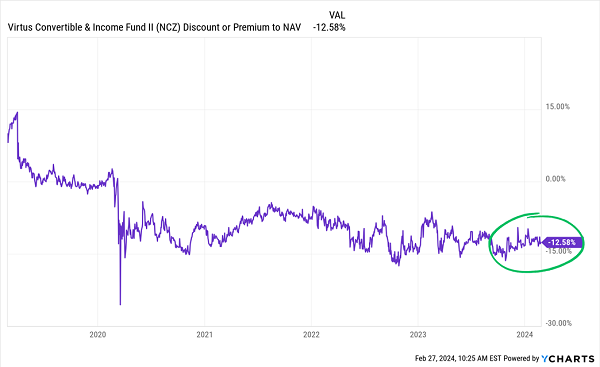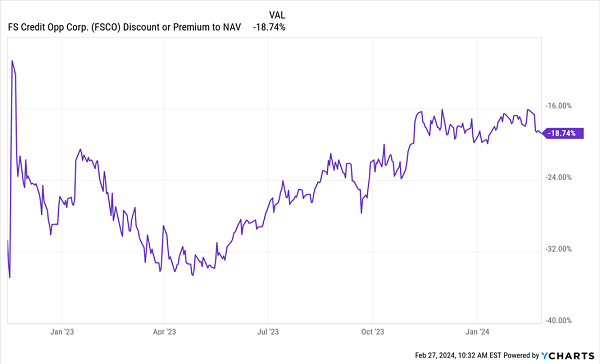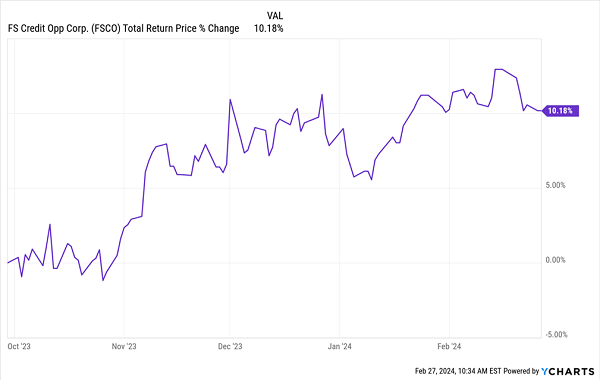There is a ton of demand for bonds out there right now, and it’s easy to see why: they’re offering big income streams—especially when you buy your high-yield “corporates” through our favorite income plays: closed-end funds (CEFs).
These days, there are plenty of CEFs kicking out yields of 12% or more. Put just $10,000 in a dividend-payer like that and you’re getting $100 per month. Or you could replace the median American income of $41,261 a year with just $342,842 invested.
These days, thanks to the Fed’s rate hikes, holding bonds—and essentially becoming a lender by doing so—means a lot more cash in your pocket, since you’re essentially “lending” at rates not seen in over two decades.
For those in the know, this has been a very profitable trend. Consider the PIMCO Dynamic Income Fund (PDI), which was yielding 16.2% when we discussed it in an article here on Contrarian Outlook on November 2, 2023.
Since then, it’s generated a total return (including its high dividend) of 14.4%, while keeping that immense payout steady.
PDI Delivers a Price- (and Dividend-) Packed Punch

Other folks saw this opportunity, too, as PIMCO recently reported $24 billion in net inflows to its bond funds in 2023. This has certainly helped the firm’s management earn more money. But it also helped increase PDI’s premium to net asset value (NAV, or the value of the bonds it holds) to a high 9.8%.
That’s a bit pricey for us at my CEF Insider service, where we always look to buy CEFs at discounts to NAV. But is buying at a discount even possible now, with bonds still rising in popularity?
The answer is a resounding yes, with dozens of CEFs currently discounted—and holding hundreds of bonds yielding more than they have in a generation.
3 “Bargain-Bin” Bond CEFs Yielding 10%+
Let’s start with the abrdn Standard Global Infrastructure Income Fund (ASGI), which yields 10.5% and boasts a steep 14.3% discount as I write this. That discount plays into dividend coverage in a way most people don’t realize, because the 10.5% headline yield on the fund is calculated based on the discounted market price, not the NAV.
But when you calculate it based on NAV, it comes out to 9%, which is the rate management must cover to keep the 10.6% payout (on market price) flowing our way. That’s a win for us because we get ASGI’s rich payout. And it’s a win for management, too, because they have a lower bar to clear to keep the dividend covered.
Another benefit: ASGI is globally diversified, as the name suggests. So if you’re wary of US assets after their recent run-up, you’re getting diversification beyond America’s shores here, since half of the fund’s positions are abroad.
Next up is the Virtus Convertible & Income Fund II (NCZ), another diversified option that keeps two-thirds of its portfolio in the US and holds tech stocks like Palo Alto Networks (PANW) and Block Inc. (SQ)—formerly known as Square—that are benefiting from the AI boom.
NCZ’s 12.6% discount to NAV and matching 12.6% yield are also extremely attractive, especially since NCZ’s discount has been testing its five-year low for more than a year. But it’s been on a slow, steady climb in more recent months.
NCZ’s Discount Starts to Claw Its Way Back

Finally, if you’re looking for an all-American option, consider the FS Credit Opportunities Corp. (FSCO), a 12%-yielding fund that combines a variety of secured bonds in a highly balanced portfolio that management believes secures its dividend and protects FSCO from bankruptcies and non-payments among the issuers of its bonds.

Source: FS Investments
That helps the fund maintain its 12% dividend yield, but the real story here is the 18.7% discount to NAV—a discount that has been steadily narrowing after dropping to the mid-30s last year, a low that few CEFs ever hit.
FSCO’s Discount Has Momentum

If more investors catch on to the big yields and gain potential that oversold bond CEFs like FSCO offer, that discount is likely to shrink further—especially since FSCO’s discount exists for the silliest of reasons: it’s a new fund.
CEF investors are a risk-averse group, and a new fund released at a time (late 2022) when bonds were at rock-bottom has made for less demand for the fund, despite the obvious fact that investors should always try to buy low and sell high.
Well, contrarians who saw the opportunity here in September, when my colleague Brett Owens wrote about this fund, have seen swift profits on top of the income stream:
FSCO Delivers a Healthy Total Return in a Short Time

Of course, with an 18.7% discount to NAV, it isn’t too late to buy FSCO, and in any case you’re getting $100 a month for every $10,000 you put in, which makes it a lot easier to wait for that discount to close.
5 Monthly Paying CEFs (Average Yield: 9.2%) That Go Way Beyond Bonds
One of the best things about these 3 high-yielding bond CEFs is that they pay dividends monthly, so we don’t have to wait for three long months to get our next payout! These dividends roll in right in line with our bills.
That’s one of the many benefits CEF investors enjoy over folks who stick with regular stocks and ETFs. And you don’t have to limit yourself to bond CEFs to get your payouts monthly, either.
The 5 CEFs in my high-income “Monthly Payer Portfolio” hold rock-steady utility stocks, real estate investment trusts (REITs), corporate bonds and blue-chip US stocks such as Amazon.com (AMZN) and Microsoft (MSFT).
These reliable CEFs give you a 9.2% average dividend stream and they’re cheap now, with 20% in price gains forecast in the next 12 months. AND, as mentioned, you get your payouts monthly, too!
